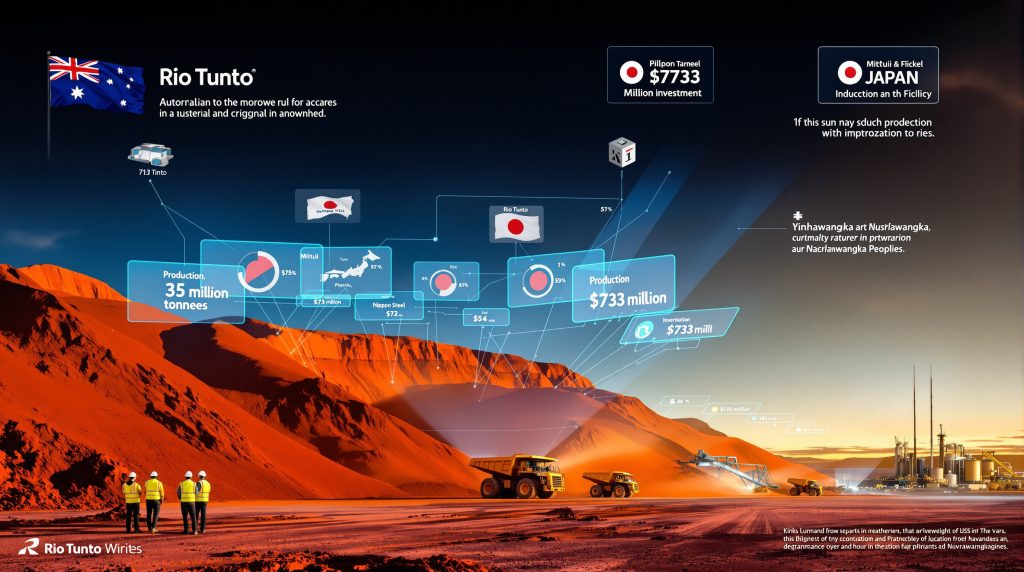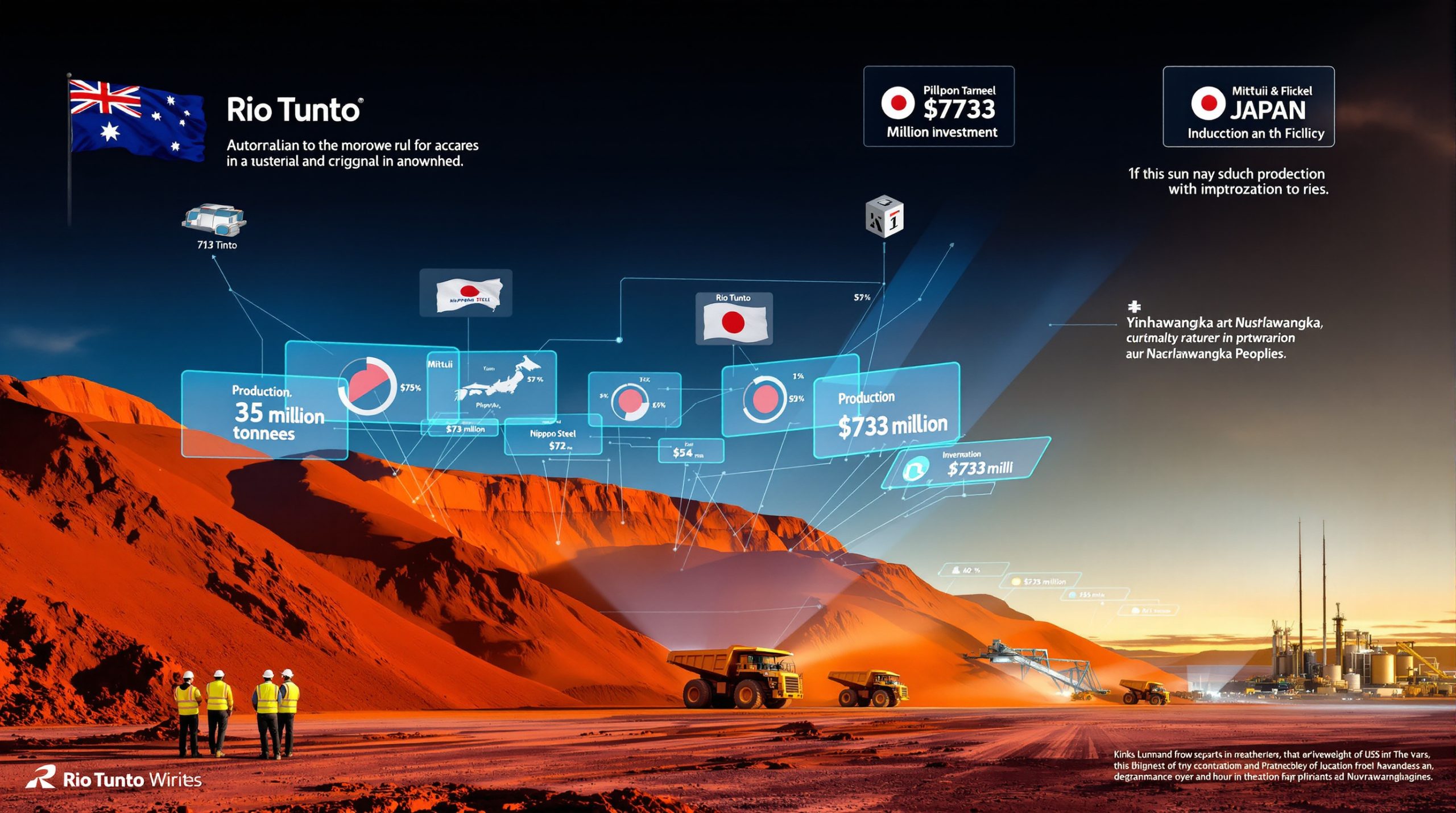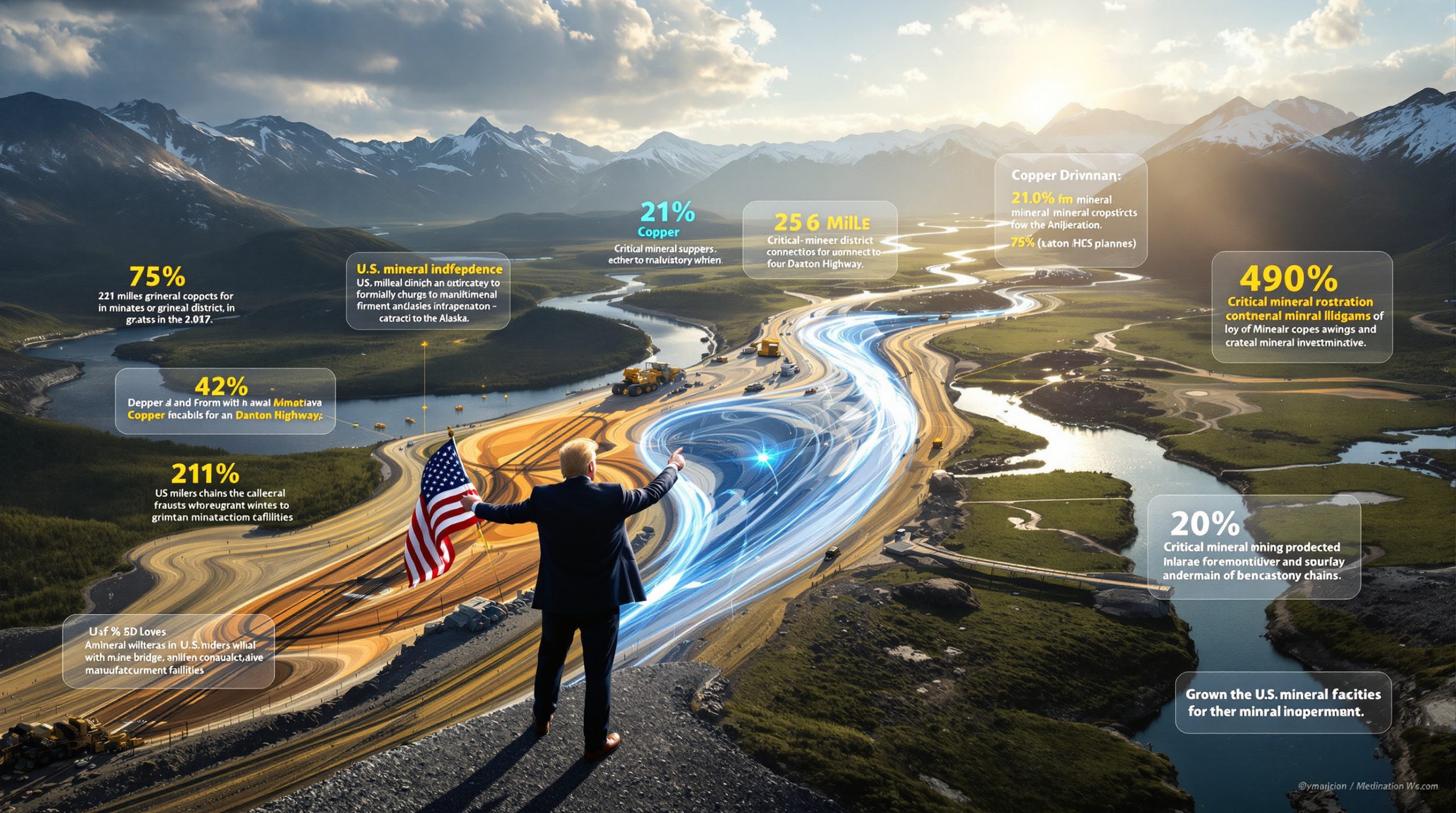Rio Tinto's $733 Million Investment in Pilbara Iron Ore: Strategic Analysis and Impact
Rio Tinto, along with joint venture partners Mitsui and Nippon Steel, has announced a significant $733 million investment in the West Angelas sustaining project located in Western Australia's Pilbara region. This strategic investment aims to maintain the hub's production capacity at 35 million tonnes annually, ensuring the continued supply of high-quality iron ore to global markets while supporting regional employment and economic development.
How Will Rio Tinto's Pilbara Investment Impact Iron Ore Production?
The West Angelas sustaining project represents a critical component of Rio Tinto's broader commitment to maintaining production capacity in the Pilbara region, where the company has established itself as a major iron ore producer since 2002. By investing $389 million of the total $733 million, Rio Tinto demonstrates confidence in the long-term viability of iron ore production in Western Australia.
The project focuses on developing new deposits within the existing West Angelas hub, taking a sustainable approach to resource management while extending the productive life of this important asset. Rather than developing entirely new mining operations, this strategy leverages existing infrastructure while accessing previously untapped reserves.
Iron Ore CEO Matthew Holcz has emphasized that the investment "ensures ongoing investment in the hub as we continue to supply high-quality, reliable iron ore to meet our global customers' demand now and into the future." This reflects the company's commitment to maintaining stable production levels while adapting to evolving iron ore price trends.
Industry analysts note that maintaining production capacity at West Angelas contributes to Rio Tinto's overall Pilbara iron ore operations, which form the backbone of the company's global portfolio. The sustaining project helps ensure consistent supply to key markets, particularly in Asia, where steel production continues to drive demand for high-grade iron ore.
What Does the West Angelas Sustaining Project Involve?
The West Angelas sustaining project encompasses several key developments designed to extend the productive life of the mining operation while implementing modern technologies and infrastructure improvements.
New Deposit Development
The core of the project involves accessing previously untapped iron ore reserves within the West Angelas hub. These new deposits will help maintain production levels without requiring entirely new mining operations, maximizing the value of existing investments in the region.
A standout feature of the new development is the implementation of autonomous trucking technology for ore transport. This technology represents the continuing evolution of mining industry innovation toward greater automation and efficiency, reducing operational costs while enhancing safety.
The project timeline indicates first ore extraction is scheduled for 2027, providing a clear roadmap for development and production activities. This timeline allows for proper planning and integration with existing operations.
Infrastructure Expansion
Supporting the new deposit development, the project includes construction of new non-process infrastructure precincts that will provide essential services and facilities for mining operations. These precincts will be designed to integrate seamlessly with existing infrastructure while meeting contemporary standards for efficiency and sustainability.
Development of 22 kilometers of haul roads will create vital connections between new mining areas and processing facilities, ensuring efficient ore transport. These roads will be designed to accommodate autonomous trucking technology, with appropriate safety systems and monitoring capabilities.
The integration with existing processing facilities maximizes capital efficiency by leveraging past investments while ensuring production continuity. This approach minimizes disruption to ongoing operations while preparing for future production needs.
Employment Generation
The project will create approximately 600 jobs during the construction phase, providing significant employment opportunities in the region. These positions will span various disciplines, including engineering, construction, logistics, and project management.
Once operational, the West Angelas sustaining project will help maintain around 950 full-time-equivalent positions, contributing to stable, long-term employment in Western Australia. These jobs include direct operational roles as well as maintenance, technical, and administrative functions.
The project will also support local supply chains and service providers, creating additional indirect employment throughout the region. This multiplier effect extends the economic benefits beyond the immediate mining operation.
Who Are the Key Partners in This Investment?
The West Angelas project operates under the Robe River joint venture structure, bringing together several major industry players with aligned interests in sustainable resource development.
Joint Venture Composition
Rio Tinto serves as the major stakeholder in the project, contributing $389 million of the total $733 million investment. As the operator, Rio Tinto brings extensive experience in iron ore mining and processing, particularly in the Pilbara region.
Mitsui, a Japanese trading and investment company with global operations, brings financial resources and market connections, particularly in Asian markets where much of the iron ore is ultimately consumed.
Nippon Steel, one of the world's leading steel producers, provides valuable end-user perspective to the joint venture, ensuring production aligns with steel manufacturing requirements.
This partnership structure distributes investment costs and risks while combining complementary strengths and capabilities. The involvement of major steel producers in the joint venture also helps secure market access for the iron ore produced.
Indigenous Partnerships
A significant aspect of the project is the collaboration with the Yinhawangka and Ngarlawangka Peoples, recognizing their traditional connection to the land and ensuring respectful development practices.
The focus on sustainable development and cultural heritage protection reflects evolving industry standards and community expectations regarding resource projects. These partnerships include ongoing dialogue and engagement throughout the project lifecycle.
The commitment to inclusive economic benefits ensures that traditional owners share in the value created by resource development on their lands. This approach aligns with contemporary standards for social license to operate in the mining industry.
Why Is This Investment Strategically Important?
The West Angelas sustaining project represents more than just a financial commitment—it's a strategic move that positions Rio Tinto to maintain its competitive advantage in the global iron ore market while embracing technological innovation and sustainable practices.
Market Position Strengthening
By maintaining Rio Tinto's production capacity in a key resource region, the investment helps preserve the company's position as one of the world's leading iron ore producers. This is particularly important in a competitive market where consistent supply capability is valued by customers.
The project ensures continued supply to meet global demand for high-quality iron ore, particularly from steel manufacturers in China, Japan, South Korea, and other industrialized economies. The grade and consistency of Pilbara iron ore make it particularly valuable in modern steelmaking processes.
The investment supports Rio Tinto's reputation for reliable delivery to customers, an important competitive advantage in long-term supply relationships. This reliability becomes increasingly important during periods of market volatility or supply chain disruption.
Technological Advancement
Implementation of autonomous trucking technology represents a significant step in Rio Tinto's ongoing digital transformation. Autonomous haulage systems have demonstrated improvements in safety, efficiency, and cost management across mining operations worldwide.
The integration of modern mining practices aligns with industry trends toward greater automation, data analytics, and remote operations. These technologies help address challenges such as skilled labor shortages while improving operational consistency.
The enhancement of operational efficiency through technology implementation helps offset rising costs in areas such as energy, labor, and regulatory compliance. This efficiency focus is particularly important in bulk commodities like iron ore, where production costs significantly impact competitiveness.
Long-term Regional Commitment
As part of a broader portfolio of replacement projects with combined capacity of approximately 130 million tonnes annually, the West Angelas investment demonstrates Rio Tinto's long-term commitment to Pilbara operations. This sustained investment provides certainty for stakeholders, including employees, suppliers, and government entities.
The project demonstrates ongoing investment in Western Australia's mining sector, reinforcing the state's position as a global resource hub. This continued investment helps maintain the skills, supply chains, and infrastructure that support the broader mining ecosystem.
Beyond the mine itself, the investment supports regional economic development through employment, procurement, and community engagement initiatives. These broader benefits help strengthen the social license to operate while contributing to regional prosperity.
How Does This Project Compare to Other Rio Tinto Investments?
The West Angelas sustaining project represents one component of Rio Tinto's comprehensive investment strategy in the Pilbara region, with several notable characteristics that position it within the company's broader portfolio.
Current Investment Portfolio
At $733 million, the West Angelas sustaining project represents a significant but measured investment that focuses on maintaining existing production capacity rather than major expansion. This approach reflects current market conditions and the maturity of Rio Tinto's Pilbara operations.
As part of a broader tranche of replacement projects with combined capacity of approximately 130 million tonnes annually, the investment fits within Rio Tinto's strategic approach to sustaining production levels. These replacement projects collectively ensure continued supply capabilities while managing capital expenditure.
The project complements other regional investments focused on maintaining production capacity, creating a balanced portfolio approach to capital allocation. This diversification helps manage development risks while ensuring consistent overall production levels.
Technological Integration
The autonomous trucking implementation at West Angelas aligns with Rio Tinto's position as a technology leader in the mining industry. The company has been at the forefront of implementing autonomous haulage systems, remote operations centers, and other digital technologies across its operations.
The project's technology focus is consistent with Rio Tinto's broader strategy of increasing automation across operations, improving safety, efficiency, and cost management. This technological emphasis distinguishes Rio Tinto from some competitors and positions the company for future industry developments.
The project's focus on enhancing safety and operational efficiency through technology demonstrates Rio Tinto's commitment to continuous improvement in mining practices. This approach helps address challenges such as skilled labor shortages while improving operational performance.
Sustainability Considerations
Development within the existing operational footprint minimizes environmental disruption compared to greenfield projects. This approach reduces clearing requirements and leverages already disturbed areas, aligning with growing stakeholder expectations regarding environmental management.
The focus on minimizing environmental impact includes considerations such as water management, energy efficiency, and rehabilitation planning. These factors are increasingly important for regulatory approval, community acceptance, and investor confidence.
The project's alignment with long-term sustainability goals reflects Rio Tinto's recognition of changing expectations regarding resource development. This includes considerations such as climate change response, water stewardship, and biodiversity management.
What Are the Economic Implications for Western Australia?
The West Angelas sustaining project delivers significant economic benefits to Western Australia, reinforcing the importance of the mining sector to the state's economy and regional development.
Employment Benefits
The creation of 600 construction jobs during the development phase provides immediate employment opportunities across various trades and professions. These positions generate income that flows through local communities and supports broader economic activity.
The 950 ongoing full-time-equivalent positions sustained by the project represent stable, long-term employment opportunities in the region. Mining jobs typically offer above-average wages, contributing significantly to regional household income.
Indirect employment through supply chains and service providers multiplies the economic impact beyond direct mine employment. Studies suggest each direct mining job supports multiple additional positions in the broader economy, particularly in regional areas.
Regional Development
Support for local businesses and contractors creates opportunities for enterprise development and growth in the region. Mining operations require diverse goods and services, from specialized equipment to everyday supplies, benefiting a range of local businesses.
Infrastructure improvements benefiting the broader community often accompany mining investments, including road upgrades, telecommunications, and community facilities. These improvements enhance regional connectivity and livability.
Skills development and training opportunities associated with the project help build human capital in the region. Mining operations require diverse skills, from technical trades to professional disciplines, creating pathways for career development.
Revenue Generation
Ongoing royalty payments to the state government contribute significantly to public finances, supporting essential services across Western Australia. Iron ore royalties have historically been a major revenue source for the state, funding education, healthcare, and other public services.
Tax contributions at local, state, and federal levels support public services and infrastructure development. These include company tax, payroll tax, and various other levies that fund government operations.
Export earnings from iron ore strengthen Australia's trade position and contribute to national economic stability. Iron ore remains Australia's largest export commodity by value, playing a crucial role in the country's economic prosperity.
The WA economic impact of the resources sector continues to be substantial, with projects like West Angelas providing significant contributions to state revenue and employment.
When Will the Project Deliver Results?
The West Angelas sustaining project follows a clear timeline for development and production, with key milestones that provide a roadmap for implementation and performance tracking.
Project Timeline
All necessary state and federal government approvals have been secured, allowing the project to proceed without regulatory delays. This regulatory certainty reduces project risk and enables confident investment decisions.
Construction is commencing immediately, with site preparation and early works already underway. This prompt start helps maintain continuity in regional employment and supply chain activity.
First ore is scheduled for extraction in 2027, providing a clear target for project completion and operational transition. This timeline allows for systematic development while maintaining current operations throughout the transition period.
Production Targets
The primary goal is maintaining 35 million tonnes annual production capacity at the West Angelas hub, ensuring continued contribution to Rio Tinto's overall Pilbara operations. This capacity maintenance approach focuses on sustaining rather than expanding production levels.
Integration with existing processing infrastructure optimizes capital efficiency and operational continuity. By utilizing established processing facilities, the project minimizes duplication and maximizes return on previous investments.
The project enables seamless transition from current to new deposit areas, maintaining production levels without significant interruption. This transition planning is critical for maintaining supply commitments to customers.
Long-term Outlook
The investment ensures West Angelas continues its contribution to Rio Tinto's broader production portfolio for years to come. As one of several operating hubs in the Pilbara, West Angelas plays an important role in the company's overall production strategy.
The project supports ongoing customer relationships by ensuring reliable supply over the medium to long term. This reliability is particularly valued in steel manufacturing, where consistent input materials are essential for operational efficiency.
The development creates a platform for potential future expansions or extensions as market conditions and resource knowledge evolve. While focused on sustaining current production, the investment maintains options for future development scenarios.
How Does This Investment Reflect Industry Trends?
Rio Tinto's investment in the West Angelas sustaining project reflects several key trends shaping the global mining industry, from technological innovation to partnership approaches and sustainability considerations.
Focus on Brownfield Development
The emphasis on maximizing value from existing operational hubs represents a widespread industry shift toward brownfield development. This approach leverages sunk costs in infrastructure and known operating environments while reducing overall development risk.
Developing within existing operations typically reduces development costs compared to greenfield projects, which require entirely new infrastructure and face greater uncertainty. This cost advantage becomes particularly important during periods of market volatility or margin pressure.
The ability to leverage established infrastructure and knowledge accelerates development timelines and improves confidence in outcomes. Operational experience at existing sites provides valuable insights that reduce technical and operational risks in expansion or sustaining projects.
Technological Innovation
The implementation of autonomous haulage systems at West Angelas reflects the broader industry movement toward automation and digitalization. Autonomous trucks have demonstrated improvements in safety, utilization, and maintenance costs across various mining operations globally.
Integration of digital technologies for operational optimization extends beyond equipment automation to include areas such as predictive maintenance, remote operations, and advanced analytics. These technologies help address productivity challenges while improving decision-making.
Enhanced safety through reduced human exposure to hazards represents a key benefit of technology adoption. By removing operators from potentially dangerous environments, autonomous systems contribute to the industry's ongoing safety improvement journey.
Partnership Approaches
Collaboration with joint venture partners distributes capital requirements and risk while bringing complementary capabilities and perspectives. The involvement of steel producers in iron ore joint ventures creates vertical integration benefits through the value chain.
Engagement with Indigenous communities recognizes their unique relationship with the land and ensures development respects cultural heritage and traditional values. This engagement has evolved from transactional consultation to more substantive partnership models.
Shared investment and risk management approaches help companies undertake projects that might be challenging for single entities. These collaborative models are becoming increasingly important as projects grow in scale and complexity.
What Environmental Considerations Apply?
The West Angelas sustaining project incorporates environmental considerations throughout its design and implementation, reflecting evolving regulatory requirements and stakeholder expectations regarding responsible resource development.
Regulatory Compliance
Securing all necessary state and federal government approvals demonstrates compliance with Australia's comprehensive environmental assessment framework. These approvals typically involve detailed evaluation of potential impacts and mitigation measures.
Adherence to stringent environmental standards covers areas such as water management, air quality, biodiversity protection, and rehabilitation planning. These standards have evolved significantly over time, with current requirements substantially more comprehensive than historical practices.
Ongoing monitoring and reporting requirements ensure continued environmental performance throughout the project lifecycle. Regular auditing and transparent reporting help maintain accountability to regulators and communities.
Resource Efficiency
Utilization of existing processing infrastructure minimizes the project's physical footprint and associated environmental disturbance. This approach reduces clearing requirements while maximizing the value derived from previously developed areas.
Optimization of water and energy use addresses two critical sustainability challenges facing mining operations, particularly in arid regions like the Pilbara. Water management strategies typically include recycling, efficiency measures, and careful monitoring of impacts on surrounding water resources.
Waste minimization strategies reduce the volume of material requiring management while maximizing resource recovery. These approaches include selective mining techniques, improved processing efficiency, and beneficial reuse of materials where possible.
Rehabilitation Planning
Progressive rehabilitation of disturbed areas reduces the project's overall environmental footprint while demonstrating commitment to responsible land management. This approach minimizes the active disturbance area at any given time while establishing rehabilitation techniques appropriate for local conditions.
Long-term closure planning integrated into project design ensures end-of-life considerations inform development decisions. Modern mining projects incorporate closure considerations from the outset, rather than addressing them only in later operational stages.
The focus on creating sustainable post-mining landscapes aims to establish ecosystems and land uses that provide ongoing environmental and community benefits. While complete restoration to pre-mining conditions is rarely achievable, contemporary rehabilitation aims to establish resilient, functional ecosystems.
The industry's growing emphasis on mine reclamation innovation reflects changing expectations about environmental stewardship and post-mining land use.
What's the Broader Significance of This Investment?
Rio Tinto's $733 million investment in the West Angelas sustaining project carries significance beyond the immediate operational benefits, reflecting broader trends in resource development and global markets.
The project demonstrates the continuing importance of iron ore to Australia's economy, with the Pilbara region remaining a world-leading source of high-quality material for global steel production. Despite periodic market fluctuations, iron ore continues to be Australia's most valuable export commodity.
Through its investment, Rio Tinto signals confidence in the long-term demand for iron ore, particularly the high-grade varieties produced in the Pilbara that help steelmakers reduce emissions and improve efficiency. This confidence comes despite uncertainty around global economic growth and steel demand.
The collaborative approach with joint venture participants and Indigenous communities highlights the evolving nature of resource development partnerships. These multi-stakeholder arrangements aim to distribute benefits while respecting different interests and perspectives.
As global supply chains face increasing scrutiny and pressure, investments like West Angelas help ensure Australia maintains its position as a reliable supplier of critical materials to international markets. This reliability becomes particularly valuable during periods of geopolitical tension or trade disruption.
The project contributes to industrial development and economic growth around the world by supplying essential raw materials for infrastructure, construction, and manufacturing. Steel remains fundamental to economic development, with iron ore serving as its primary input.
The West Angelas sustaining project also represents an example of balancing economic development with environmental and social considerations in resource projects. This balancing act characterizes contemporary mining investment decisions, with increasing emphasis on sustainable development principles.
Future Outlook and Considerations
Looking forward, the West Angelas project highlights several important trends that will likely shape the future of iron ore mining and broader resource development in Australia.
The increasing implementation of autonomous and remote technologies will continue to transform mining operations, with implications for workforce skills, operational efficiency, and community relationships. Mining companies will need to manage this transition thoughtfully, addressing concerns about job displacement while creating new opportunities.
Environmental performance expectations will continue to evolve, with growing emphasis on climate impact, water management, and biodiversity outcomes. Future developments may face more stringent requirements regarding carbon emissions and water use efficiency.
Relationships with Traditional Owners will become increasingly central to resource development, with growing recognition of Indigenous rights and cultural heritage considerations. Companies that develop genuine partnerships based on mutual respect and shared benefit will likely achieve better outcomes.
Market dynamics for iron ore will continue to be influenced by Chinese economic performance, global decarbonization efforts, and the emergence of potential substitute materials and processes. While demand remains strong currently, producers must remain attentive to these evolving factors.
The West Angelas sustaining project demonstrates how mature mining regions can continue to deliver value through careful resource management, technological innovation, and collaborative approaches. This model may become increasingly important as other mining regions mature.
The investment also highlights the continuing importance of the resources sector to Western Australia's economy and communities, even as the state seeks to diversify its economic base. Finding the right balance between resource development and economic diversification remains an ongoing challenge.
Through investments like the West Angelas sustaining project, companies like Rio Tinto are not just maintaining production capacity but also adapting to changing expectations about how resources should be developed and the benefits they should deliver to various stakeholders.
According to a recent Reuters report, the project reinforces Rio Tinto's position as one of the world's premier iron ore suppliers while the Robe River joint venture announcement highlights the long-term strategic importance of maintaining production capacity in key mining regions through careful investment and iron ore forecast insights.
Searching for the Next Significant Mineral Discovery?
Discover how major mineral discoveries like those by De Grey Mining and WA1 Resources can generate exceptional returns by exploring Discovery Alert's dedicated discoveries page at https://discoveryalert.com.au/discoveries/, where our proprietary Discovery IQ model instantly transforms complex mineral data into actionable investment opportunities.




